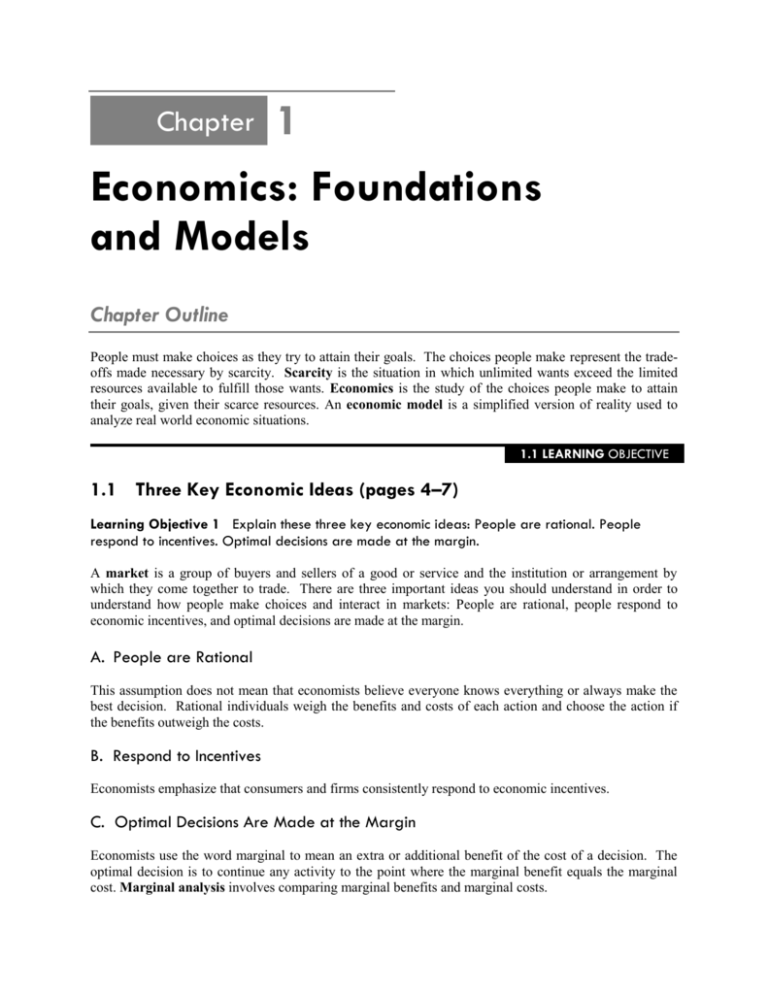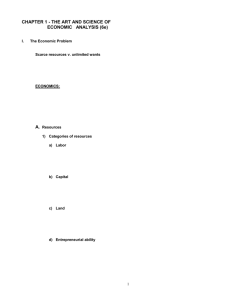Economics: Foundations and Models
advertisement

1 Economics: Foundations and Models Chapter Chapter Outline People must make choices as they try to attain their goals. The choices people make represent the tradeoffs made necessary by scarcity. Scarcity is the situation in which unlimited wants exceed the limited resources available to fulfill those wants. Economics is the study of the choices people make to attain their goals, given their scarce resources. An economic model is a simplified version of reality used to analyze real world economic situations. 1.1 LEARNING OBJECTIVE 1.1 Three Key Economic Ideas (pages 4–7) Learning Objective 1 Explain these three key economic ideas: People are rational. People respond to incentives. Optimal decisions are made at the margin. A market is a group of buyers and sellers of a good or service and the institution or arrangement by which they come together to trade. There are three important ideas you should understand in order to understand how people make choices and interact in markets: People are rational, people respond to economic incentives, and optimal decisions are made at the margin. A. People are Rational This assumption does not mean that economists believe everyone knows everything or always make the best decision. Rational individuals weigh the benefits and costs of each action and choose the action if the benefits outweigh the costs. B. Respond to Incentives Economists emphasize that consumers and firms consistently respond to economic incentives. C. Optimal Decisions Are Made at the Margin Economists use the word marginal to mean an extra or additional benefit of the cost of a decision. The optimal decision is to continue any activity to the point where the marginal benefit equals the marginal cost. Marginal analysis involves comparing marginal benefits and marginal costs. 1.2 LEARNING OBJECTIVE 1.2 The Economic Problem That Every Society Must Solve (pages 8–11) Learning Objective 2 Discuss how an economy answers these questions: What goods and services will be produced? How will the goods and services be produced? Who will receive the goods and services? Any society faces the economic problem that it has only a limited amount of economic resources and so can produce only a limited amount of goods and services. Society faces trade-offs. A trade-off is the idea that because of scarcity, producing more of one good or service means producing less of another good or service. Trade-offs force society to answer three fundamental questions: 1. What goods and services will be produced? 2. How will the goods and services be produced? 3. Who will receive the goods and services? A. Centrally Planned Economies versus Market Economies Societies organize their economies in two main ways. A centrally planned economy is an economy in which the government decides how economic resources will be allocated. A market economy is an economy in which the decisions of households and firms interacting in markets allocate economic resources. B. The Modern “Mixed” Economy The high rates of unemployment and business bankruptcies of the Great Depression caused a dramatic increase in government intervention in the economy in the United States and other market economies. Some government intervention is designed to raise the incomes of the elderly, the sick, and people with limited skills. In recent years, government intervention has expanded to meet social goals such as protection of the environment and the promotion of civil rights. Some economists argue that government intervention makes it more accurate to refer to the U.S. and other nations as mixed economies rather than market economies. A mixed economy is an economy in which most economic decisions result from the interaction of buyers and sellers in markets, but in which the government plays a significant role in the allocation of resources. In recent years, China has moved from being a centrally planned economy to being a more mixed economy. Production of most goods is determined in markets. C. Efficiency and Equity Market economies tend to be more efficient than planned economies. There are two types of efficiency. Productive efficiency is the situation in which a good or service is produced at the lowest possible cost. Allocative efficiency is a state of the economy in which production is in accordance with consumer preferences; in particular, every good or service is produced up to the point where the last unit produced provides a marginal benefit to society equal to the marginal cost of producing it. Voluntary exchange is the situation that occurs in markets when both the buyer and seller of a product are made better off by the transaction. Markets promote efficiency but don’t guarantee it. Inefficiency arises from various sources: It may take time for firms to achieve productive efficiency; governments may reduce efficiency by interfering with voluntary exchanges in markets; the production of some goods may damage the environment when firms ignore the costs of environmental damage. Society may not find efficient economic outcomes to be desirable. Many people prefer economic outcomes that they consider fair or equitable even if these outcomes are less efficient. Equity is the fair distribution of economic benefits. Equity is harder to define than efficiency. Programs designed to increase equity may reduce efficiency. 1.3 LEARNING OBJECTIVE 1.3 Economic Models (pages 11–15) Learning Objective 3 Understand the role of models in economic analysis. Models are simplified versions of reality used to analyze real-world situations. To develop a model, economists generally follow five steps. 1. 2. 3. 4. 5. Decide on the assumptions to be used in developing the model. Formulate a testable hypothesis. Use economic data to test the hypothesis. Revise the model if it fails to explain well the economic data. Retain the revised model to help answer similar economic questions in the future. A. The Role of Assumptions in Economic Models Models are based on making assumptions because models must be simplified to be useful. For example, when using models, economists make behavioral assumptions about the motives of consumers and firms. Economists assume consumers will buy goods and services that will maximize their satisfaction. Economists assume firms will act to maximize their profits. An economic variable is something measurable that can have different values, such as the wages of software programmers. A hypothesis in an economic model is a statement that may be correct or incorrect about an economic variable. An economic hypothesis is usually about a causal relationship; for example, “outsourcing leads to lower wages for software programmers.” Positive analysis is analysis concerned with what is. Normative analysis is analysis concerned with what ought to be. 1.4 LEARNING OBJECTIVE 1.4 Microeconomics and Macroeconomics (page 15) Learning Objective 4 Distinguish between microeconomics and macroeconomics. Microeconomics is the study of how households and businesses make choices, how they interact in markets, and how the government attempts to influence their choices. Macroeconomics is the study of the economy as a whole, including topics such as inflation, unemployment, and economic growth. 1.5 LEARNING OBJECTIVE 1.5 A Preview of Important Economic Terms (pages 15-16) Learning Objective 5 Become familiar with important economic terms. Review the terms and definitions Appendix Using Graphs and Formulas Learning Objective: Review the use of graphs and formulas. Graphs simplify economic ideas and help make ideas more concrete. Economists and policymakers can use graphs to help solve real-world problems. A. Graphs of One Variable Figure 1A-1 displays examples of two common types of graphs: bar graph and pie charts. The height of the bars in the bar graph represents the market shares of automobile firms. The pie chart shows the same information with each market share by the size of the pie’s slice. Information on economic variables can also be displayed in time-series graphs. These graphs are displayed on a coordinate grid. The vertical axis (y-axis) of a coordinate grid measures the value of one variable. The point where the vertical axis intersects the horizontal axis is the origin. The horizontal axis of a coordinate grid measures the value of another variable. The points in a coordinate grid represent the values of the two variables. Figure 1A-2 illustrates and example of a time-series graph. B. Graphs of Two Variables Both microeconomics and macroeconomics use two-variable graphs extensively. Figure 1A-3 illustrates the graph of a linear or straight-line demand curve where price is measured along the vertical axis and quantity is measured along the horizontal axis. C. Slopes of Lines The slope of a straight line indicates how much the variable measured along the y-axis changes as the variable measured along the x-axis changes. Slope can be measured between any two points on the line since the slope of a straight line has a constant value. Slope can expressed as the change in the value measured on the vertical axis divided by the change in the value measured on the horizontal axis; slope can also expressed using the Greek letter delta (Δ) to stand for the change in a variable (slope = Δy /Δx). The slope is also referred to as the rise over the run. Slope Change in value on the vertical axis y Rise Change in the value on the horizontal axis x Run D. Taking Into Account More Than Two Variables on a Graph The demand curve in Figure 1A-4 shows the relationship between the price of pizza and the quantity of pizza sold but the quantity of any good sold depends on more than just the price of the good. Allowing other variables to change will cause the position of the demand curve in the graph to change. The table in Figure 1A-5 shows the effect of a change in the price of hamburgers on the quantity of pizza demanded. By shifting the demand curve we take into account the effect of changes in a third variable. E. Positive and Negative Relationships Sometimes the relationship between two variables is negative, as in the case with the price of pizza and the quantity of pizza demanded. The relationship between two variables can be positive, as shown in Table 1A-6 which shows values for income and consumption spending for the years 2003-2006. F. Determining Cause and Effect Inferring cause and effect relationships by observing graphs can lead to incorrect conclusions. One reason for this is that there may be an omitted variable that is not accounted for in the graph. A related problem in determining cause and effect is reverse causality; this occurs when we conclude that changes in variable X cause changes in variable Y, when changes in variable Y cause changes in variable X. G. Are Graphs of Economic Relationships Always Straight Lines? The relationship between two variables is linear when it can be represented by a straight line. Few economic relationships are actually linear. However, it is often useful to approximate a nonlinear relationship with a linear relationship. H. Slopes of Nonlinear Curves To measure the slope of a nonlinear curve at a particular point, we must measure the slope of a tangent to the curve at that point. A tangent line touches the curve at only one point. The slope of a tangent is measured in the same way as the slope of any straight line. I. Formulas This section reviews several useful formulas and show how to use them. J. Formula for a Percentage Change The formula for a percentage change between two variables for any two periods: Percentage change Value in the second period - Value in the first period x 100 Value in the first period K. Formulas for the Areas of a Rectangle and a Triangle The formula for the area of a rectangle is base x height. The formula for the area of a triangle is ½ x base x height.







